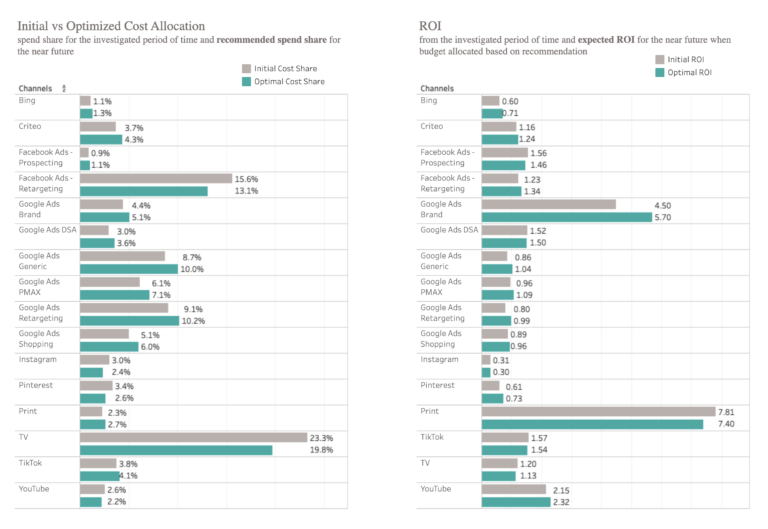Measuring Marketing ROI in a Cookieless World
With the impending end of cookie support, marketers stand before a major challenge: How to measure and optimize marketing activities when the old techniques such as user-based attribution (based on cookie-level data) are no longer reliable?
Measurement is a Key Challenge for Marketers Today
What is the True ROI of my Marketing Channels?

Getting insight into the true return on marketing investment has become more and more difficult due to cookie limitations which cause significant data gaps, resulting in inaccurate calculation of channel ROI. This leads to bad business decisions. So how to get answers to the questions such as:
- What is the ROI on our display advertising spend?
- To which media/publisher should we increase or decrease spend?
- What is our ROI when approximately 35% users have not been tracked due to missing content?

Getting insight into the true return on marketing investment has become more and more difficult due to cookie limitations which cause significant data gaps, resulting in inaccurate calculation of channel ROI. This leads to bad business decisions. So how to get answers to the questions such as:
- What is the ROI on our display advertising spend?
- To which media/publisher should we increase or decrease spend?
- What is our ROI when approximately 35% users have not been tracked due to missing content?
The answer lies in using measurement techniques that do not require user-level (cookie based) data – one prime example is modern automated marketing mix modelling (MMM). MMM is completely independent of cookies and is a time tested approach that has been used by Fortune 500 companies to measure marketing effectiveness – but technological advances in the past few years are making it widely available for all advertisers. MMM is a method recommended nowadays e.g. by Meta/Facebook, Google or TikTok to measure both short-term and long-term effects of advertising.
What is Marketing Mix Modelling?
Statistical modelling technique to find the relationship between channel marketing investment (and media exposure – impressions, GRPs,…) and its effect on the target metric (typically revenue).
Key Benefits of MMM in a nutshell:
- Budget optimization - MMM shows the optimal budget allocation
- Cookieless approach - no cookie dependent input data needed
- Covers online and offline channels
- Long-term effects - measures long term efffects of advertising
Marketing Mix Modelling is a Proven Way to Measure Marketing ROI Without Cookies
MMM Solution Delivery
Example for a DTC Advertiser
1.
Channels Structure Review
Week 1
Together with the client we reviewed their “channel grouping” – how they structure their marketing channels (both online and offline) resulting in a total of 27 channels, with for example Facebook being broken down into 5 different subchannels based on the targeting and creative approach (e.g. “Product Ads – Retargeting” or “Main promotions – reach” etc.).
2.
Connecting Data
Week 1
We connected to all the advertising platforms for data – requiring no IT capacities on the customer side for the integration.
3.
Modelling
Week 2
We got to the step of marketing mix model preparation and calibration. We use state-of-the-art machine learning and statistical modelling methods to prepare a model with high accuracy and predictive power.
4.
Visualization
Week 2
Visualization in the form of customized dashboards is available in a web application interface or alternatively in all major BI tools such as Tableau, Looker / Data Studio, Power BI.
5.
Optimal Budget Allocation
Week 3
MMM solution not only offers reporting of past performance but also recommends the optimal marketing budget mix. In this case showing an uplift of 14% revenue for the same marketing budget – just with different allocation among channels.
6.
Always-On Solution
Week 3
Handover workshop with the customer – first batch of recommendations to optimize their marketing budget from our analytics team. New data is automatically fetched from the platforms and the model and results are updated on a daily basis. The marketing team now has always-on dashboards with accurate and reliable results of their campaigns – from branding and prospecting video to lower-funnel retargeting or branded search.
Sample MMM Results
Optimal vs Actual Current Levels of Spend and ROI by Channel
Modern MMM solutions not only report actual channel or campaign ROI but also recommend optimal budget allocation – you can set constraints for each channel and let the MMM engine optimize your overall ROI respecting these constraints – thus improving the overall effectiveness.
Modern MMM solutions also work as an “always-on” software application (or live BI dashboards) where the marketer can view daily or weekly updated results of their campaigns.
Pricing
How Much Does It Cost?
MMM Basic
-
Suitable for e-commerce and DTC companies investing in digital channels
-
Automated MMM with weekly model + results updates
-
Interactive budget optimizer
-
Tableau, PowerBI or Looker studio dashboards available
-
Support via email
-
No IT needed for implementation
-
Data onboarding for 20 most common digital channelsList Item
MMM Plus
-
Suitable for companies investing in online and offline marketing
-
All in Basic and:
-
All digital channels incl. custom connectors
-
Offline media channels
-
Pricing and discounting effects modelled
-
External factors (competition, weather etc)
-
Profit vs Sales Growth trade-off modelling
-
Daily model + results updates
-
Dedicated Customer Success Manager
MMM One-time
-
Suitable for and ad hoc review of your current marketing effectiveness
-
One-time MMM analysis for a selected period
-
Multiple budget optimization scenarios
-
Comprehensive analysis and recommendations for your marketing team
-
Workshop to discuss results
-
Online dashboard with results
MMM Enterprise
-
Suitable for larger advertisers with multiple sales channels or complex brand portfolio
-
Multiple target KPIs (Sales, Profit, Traffic, App Installs,...)m
-
Unlimited models (eg for multiple brands, countries or business KPIs)
-
On-premise deployment available
-
Custom integration with your internal systems
-
Dedicated Customer Success Manager and Analyst
-
Enterprise-level SLA
FAQ
Find Out More about MMM
Normally it is recommended to have least 2 years of historical data, however businesses that are not affected by seasonality can do with shorter history.
Multi-touch attribution (MTA) for each conversion (order, app install,…) tries to reconstruct the touchpoints (these may be ad clicks, direct visits, display ad views etc.) that preceded it for the given user and then using some set of rules it distributes the credit for that conversion to some or all of the touchpoints.
Marketing Mix Modelling is a method based on statistical modelling with the aim of finding the correlation between marketing cost (and/or media exposure) and target metrics such as revenue, number of new customers or number of app installs on a “macro level”. In this context the macro level means “top-down” approach working with aggregated data – such as sales and investment breakdown by days or weeks – at the level of marketing channels and campaign types (both online and offline).
Both of the methods have the same goal measure the business impact of marketing channels and help marketers invest their budget more effectively.
Would you like to find out more about the differences? Feel free to take a look at our article about MMM vs MTA.
There is no technically required minimum but once you invest at least 10ths USD per month into marketing and use several marketing channels, MMM is likely to be useful to your company.
Marketing Mix Modelling includes other factors than media – such as pricing, macroeconomic factors, weather etc – in the model, while Media Mix Modelling only focuses on media. But in practice many people use these terms interchangeably.

